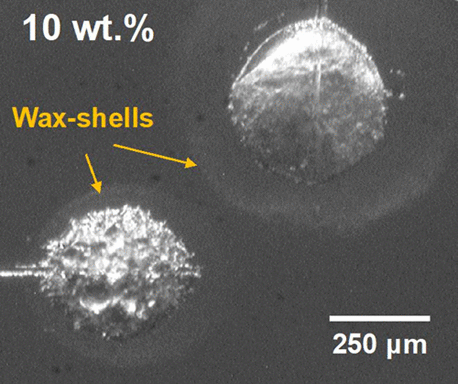当前位置:
X-MOL 学术
›
Energy Fuels
›
论文详情
Our official English website, www.x-mol.net, welcomes your
feedback! (Note: you will need to create a separate account there.)
Influence of Wax on Cyclopentane Clathrate Hydrate Cohesive Forces and Interfacial Properties
Energy & Fuels ( IF 5.2 ) Pub Date : 2020-01-16 , DOI: 10.1021/acs.energyfuels.9b03543 Wei Wang 1, 2 , Qiyu Huang 1 , Sijia Hu 2 , Peng Zhang 2 , Carolyn A. Koh 2
Energy & Fuels ( IF 5.2 ) Pub Date : 2020-01-16 , DOI: 10.1021/acs.energyfuels.9b03543 Wei Wang 1, 2 , Qiyu Huang 1 , Sijia Hu 2 , Peng Zhang 2 , Carolyn A. Koh 2
Affiliation

|
As pipeline transportation in the oil and gas industry is moving to offshore conditions, the prevalent high-pressure and low-temperature conditions in the subsea flow lines may lead to hydrate formation and wax precipitation occurring simultaneously. The presence of wax may alter the interfacial properties and particle interactions, resulting in the change in hydrate cohesion behavior. In this study, cyclopentane hydrate cohesive forces are measured with different wax contents using a micromechanical force (MMF) apparatus. A custom wax sample with the composition from C17 to C39 was mixed with cyclopentane and used as the bulk phase. It was found that the cohesive force decreased with increasing wax content from 0 to 5 wt % then increased with further wax contents from 5 to 8.75 wt %. Dilution MMF measurements demonstrated that two competitive mechanisms, the oleophilic effect and reduced hydrate conversion rate were synergistically responsible for the observed changes in the cohesive force. In an MMF measurement with 10 wt % wax and 6 h annealing period, the wax was found to deposit on the hydrate surface and effectively reduced the cohesive force, indicating that wax crystals have a potentially inhibiting effect on hydrate cohesion. Furthermore, the bulk phase/water interfacial tension decreased with increasing wax contents. Finally, a possible mechanism is presented to illustrate the effect of wax on the hydrate cohesive force, considering the oleophilic effect, hydrate conversion, and wax deposition. This work provides insight into the influencing mechanisms of wax on hydrate cohesion, which can be useful for flow assurance applications where both hydrates and waxes are present.
中文翻译:

蜡对环戊烷包合物水合物内聚力和界面性质的影响
随着石油和天然气行业中的管道运输正在向海上条件转移,海底流线中普遍存在的高压和低温条件可能导致水合物形成和蜡沉淀同时发生。蜡的存在可能会改变界面性质和颗粒相互作用,从而导致水合物内聚行为的改变。在这项研究中,使用微机械力(MMF)仪器测量了不同蜡含量下的环戊烷水合物内聚力。将组成为C17至C39的定制蜡样品与环戊烷混合,并用作本体相。已经发现,内聚力随着蜡含量从0到5wt%的增加而降低,然后随着蜡含量从5到8.75wt%的增加而增加。稀释MMF测量结果表明亲油效应和降低的水合物转化率这两个竞争机制是观察到的内聚力变化的协同增效因素。在使用10 wt%蜡和6 h退火时间的MMF测量中,发现蜡沉积在水合物表面并有效降低了内聚力,表明蜡晶体可能对水合物的内聚具有抑制作用。此外,本体相/水界面张力随蜡含量的增加而降低。最后,考虑亲油性,水合物转化率和蜡沉积,提出了一种可能的机理来说明蜡对水合物内聚力的影响。这项工作可洞察蜡对水合物凝聚力的影响机制,
更新日期:2020-01-17
中文翻译:

蜡对环戊烷包合物水合物内聚力和界面性质的影响
随着石油和天然气行业中的管道运输正在向海上条件转移,海底流线中普遍存在的高压和低温条件可能导致水合物形成和蜡沉淀同时发生。蜡的存在可能会改变界面性质和颗粒相互作用,从而导致水合物内聚行为的改变。在这项研究中,使用微机械力(MMF)仪器测量了不同蜡含量下的环戊烷水合物内聚力。将组成为C17至C39的定制蜡样品与环戊烷混合,并用作本体相。已经发现,内聚力随着蜡含量从0到5wt%的增加而降低,然后随着蜡含量从5到8.75wt%的增加而增加。稀释MMF测量结果表明亲油效应和降低的水合物转化率这两个竞争机制是观察到的内聚力变化的协同增效因素。在使用10 wt%蜡和6 h退火时间的MMF测量中,发现蜡沉积在水合物表面并有效降低了内聚力,表明蜡晶体可能对水合物的内聚具有抑制作用。此外,本体相/水界面张力随蜡含量的增加而降低。最后,考虑亲油性,水合物转化率和蜡沉积,提出了一种可能的机理来说明蜡对水合物内聚力的影响。这项工作可洞察蜡对水合物凝聚力的影响机制,











































 京公网安备 11010802027423号
京公网安备 11010802027423号